Incredibly enough, all three of the latest Shonen Jump Championships featured a duelist running multiple copies of the incredibly rare SJC promo card, Shrink. Hugo Adame managed to procure two copies for his fascinating deck at Shonen Jump Indianapolis, piloting the build to a tenth place finish. Then I had the chance to meet David Jamieson at SJC Hamilton. We had the chance to speak about Shrink and its remarkable powers. After discussing strategy and possible deck-building suggestions with the man, I saw him utilize a unique build in the Sunday regional event that focused on teched Warriors such as Cliff the Trap Remover and Don Zaloog.
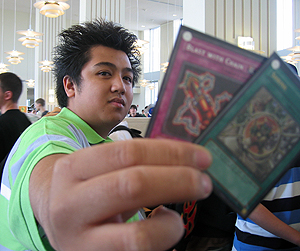 Just when I thought I’d seen enough Shrink cards in two weeks, at the very next event, the face of Canadian Yu-Gi-Oh! brought it out for Shonen Jump Boston! The build that Dale Bellido chose to run featured Shrink in a far more aggressive deck. Using three copies of the resurgent Hydrogeddon with a contingent of popular battle monsters, Bellido also decided to play Blast with Chain for more combat tricks.
Just when I thought I’d seen enough Shrink cards in two weeks, at the very next event, the face of Canadian Yu-Gi-Oh! brought it out for Shonen Jump Boston! The build that Dale Bellido chose to run featured Shrink in a far more aggressive deck. Using three copies of the resurgent Hydrogeddon with a contingent of popular battle monsters, Bellido also decided to play Blast with Chain for more combat tricks.
I think we can learn from their deck-building choices and create something that does justice to Hugo and Dale’s original vision.
Creating Advantage through the Shrink Control Concept
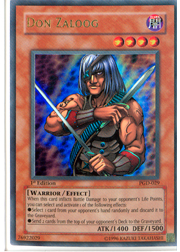 There were a few cards and concepts that Adame and Bellido’s build shared, even though they were designed for two different formats. The first is surprising the opponent with monsters like Don Zaloog and Airknight Parshath. Hugo chose to main-deck one copy of Airknight and three copies of Don Zaloog, while Dale went with two of each. No surprises there; both are great with Shrink.
There were a few cards and concepts that Adame and Bellido’s build shared, even though they were designed for two different formats. The first is surprising the opponent with monsters like Don Zaloog and Airknight Parshath. Hugo chose to main-deck one copy of Airknight and three copies of Don Zaloog, while Dale went with two of each. No surprises there; both are great with Shrink.
Both players also decided to use triple Mystic Tomato, a great self-replacing monster that leads into the powerhouse Don Zaloog and sets up the early game. This naturally led to the inclusion of a single Newdoria and Sangan as additional monsters for you to search for with Tomato.
The question is what other monster choices work well. Hugo, deciding to tech against the Chaos builds that were dominant before this September, chose to use two copies of Banisher of the Radiance and one Kycoo the Ghost Destroyer, in a build reminiscent of Jake McNeely’s stunner at Shonen Jump Championship Arlington. Dale, on the other hand, adjusting to the current environment, felt that the field control provided by Hydrogeddon was just right.
When creating a list of monsters that Hugo could explore in preparation for GenCon Indy, I threw out almost all of the solid monsters listed in my advantage through battle article. Winged Sage Falcos, Sasuke Samurai #4, Hydrogeddon, and others were all tested thoroughly. In the end, he chose to forego fancy tricks for substance. Dale seems to have taken the same approach, so our build on New Grounds will try to find a compromise between the more control-based Adame type and Bellido’s aggressive, field-dominating build. Of course, the primary strength of the deck comes from using Shrink with Don or Airknight during the damage step.
Build: North America’s Shrink Control
General Synergies and Goals:
1) Use Shrink to take control of the field.
Pivotal Cards:
1) Don Zaloog and Airknight Parshath
2) Shrink
Constructing the Monster Lineup of the North American Shrink Control Deck
Notice the beauty of one of America’s finest banding together with one of Canada’s best players! The cooperation and unity shown by two neighboring nations is almost enough to reduce one to tears!
We’ll start with the monster choices that both players agreed upon.
Framework for Shrink Control:
3 Mystic Tomato
1 Zaborg the Thunder Monarch
1 Newdoria
1 Sangan
1 Breaker the Magical Warrior
2 Don Zaloog
2 Airknight Parshath
1 Treeborn Frog
1 Magician of Faith
2 Cyber Dragon
1 Exiled Force
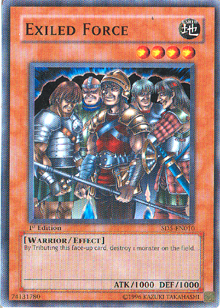 This is a rather thick list. I chose to go with Dale’s two Airknight Parshath cards, since Hugo’s build chose to main-deck one in the era of Snatch Steal. Snatch Steal’s status on the Forbidden list means that using more copies of the Airknight is much more feasible. Both players chose to use Exiled Force, although it was limited at the time of Hugo’s build. I chose to go with one copy of the card, which can be fetched with two copies of Reinforcement of the Army.
This is a rather thick list. I chose to go with Dale’s two Airknight Parshath cards, since Hugo’s build chose to main-deck one in the era of Snatch Steal. Snatch Steal’s status on the Forbidden list means that using more copies of the Airknight is much more feasible. Both players chose to use Exiled Force, although it was limited at the time of Hugo’s build. I chose to go with one copy of the card, which can be fetched with two copies of Reinforcement of the Army.
As field presence becomes more of a priority for players, we’re beginning to see an environment where running multiple copies of Cyber Dragon (due to its special summon ability) is a popular choice. With sixteen monster slots already accounted for, this gives us quite a bit of room to work with in this column. It’s my job to include six to eight more monsters that stay true to the original vision that the creators were aiming for.
Monsters: 22
3 Mystic Tomato
1 Newdoria
1 Sangan
1 Zaborg the Thunder Monarch
1 Breaker the Magical Warrior
2 Don Zaloog
2 Airknight Parshath
1 Treeborn Frog
2 Cyber Dragon
1 Exiled Force
+ 1 Strike Ninja
+ 1 Asura Priest
+ 1 D. D. Assailant
+ 1 D. D.Warrior Lady
+ 1 D. D. Warrior
+ 2 Gravekeeper’s Spy
Changes to the Original Build: If you’re comparing this to Dale’s build, it’s lost many of the powerful aggro capabilities that he masterfully exploited. However, it has shored up some of the weaknesses that were illustrated quite clearly through Dale’s featured match with Chris Evans. Hydrogeddon and Asura Priest run roughshod over the Tomato recruiter engine! While these cards were not played as much in the format that Hugo designed the deck for, we must be mindful of those two power cards that can completely alter the game state.
The answer to both is to either run monsters with healthy DEF values, such as Gravekeeper’s Spy or Legendary Jujitsu Master, or to use monsters with high ATK values that can seize control of the field. First, since the deck seems to support the Creature Swap engine quite well, we’ve added a copy of Asura Priest. Asura Priest works wonderfully well with Creature Swap and Shrink, and can often clear the entire field with just one copy of Shrink in hand.
Next, we’ll throw in a copy of D. D. Assailant. Dale, like almost all duelists in this environment, had a problem at times with Breaker the Magical Warrior floating on the field without a counter. It slashed into a boosted Newdoria with Shrink, and also allowed a Last Will activation for Don Zaloog. Cards like D. D. Assailant, Asura Priest, and Strike Ninja help stymie the onslaught of 1600 ATK monsters such as Hydrogeddon and Breaker the Magical Warrior. To this end, D. D. Assailant is one of the most stable monsters the Shrink build can utilize.
Let’s also throw in a copy of D. D. Warrior Lady. Monster removal is too precious to ignore in this environment, and Treeborn Frog is such a huge threat that we sometimes have to try to get rid of it at all costs. D. D. Warrior Lady is one of the few monsters in our arsenal that gives us that luxury. Since we’re able to use two copies of Shrink, I also won’t hesitate to throw in a copy of D. D. Warrior as well. Paul Levitin used this card to great effect in his Earth control deck at Boston, and I was quite impressed by its results in testing.
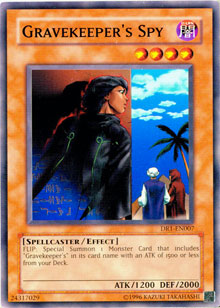 Finally, we’ll round out the list with two copies of Gravekeeper’s Spy. It blocks almost all attacks for a turn, can trade off in battle with Monarchs with the help of Shrink, and can push for 2400 damage a turn on a clear field. It’s not fun to take 2400 damage, summon Cyber Dragon, swing into a Shrink-boosted Spy, and then have to take 2400 damage again the next turn.
Finally, we’ll round out the list with two copies of Gravekeeper’s Spy. It blocks almost all attacks for a turn, can trade off in battle with Monarchs with the help of Shrink, and can push for 2400 damage a turn on a clear field. It’s not fun to take 2400 damage, summon Cyber Dragon, swing into a Shrink-boosted Spy, and then have to take 2400 damage again the next turn.
Every single monster in this deck can support itself. Strike Ninja has a healthy set of ten Dark monsters to remove. Airknight Parshath can be tributed through Spy, Sangan, Frog, Cyber Dragon, or general field-support monsters like Mystic Tomato.
Now that we have a very, very stable base of monsters to work with, let’s build the spell and trap support.
Spell and Trap Support for the North American Shrink Control Deck
I think both duelists would agree that these spells are important for the deck.
Original Spell Framework:
1 Graceful Charity
1 Confiscation
1 Heavy Storm
2 Shrink
1 Nobleman of Crossout
1 Premature Burial
Lately, I’ve been rethinking the wisdom of decreeing Mystical Space Typhoon a spell staple. It was quite necessary to use it in the era of Snatch Steal, when it could prevent the huge swings which that equip spell creates. It also helped block against Royal Decree, a big problem card for many matchups. Now, however, it’s almost bound to hit something chainable like Scapegoat or Ring of Destruction and skilled, nefarious duelists are teching against it by using cards like Jar of Greed!
I’d definitely urge some of you to revisit Mystical Space Typhoon and decide whether it’s a mainstay in this period of dueling. I’ve chosen not to include it in this build because Shrink can hopefully provide enough battle trickery by itself to warrant only a few pieces of spell or trap removal.
Instead, we can work around the opponent’s defenses by using more versatile cards. One is Book of Moon, a card that’s steadily falling off many duelists’ radars. It provides important defense against Brain Control and Smashing Ground, two popular cards in this format, and has incredible synergy with almost every monster in our deck. Since almost every single monster replaces itself or provides a “D. D.” effect, there’s no problems with using Moon in response to a Ring, Sakuretsu Armor, Mirror Force, or any similar card. Giving it this extra dimension makes Book of Moon incredibly versatile without losing advantage. Huge.
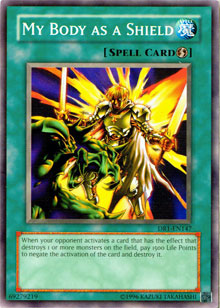 Let’s throw in a copy of My Body as a Shield to counter the multiple Zaborg cards being main-decked by many popular decks. Players are swiftly realizing that Monarchs are far more durable than previously believed, and swinging for 2400 damage in a turn is nothing to sneeze at. The one weakness of Shrink is that it begins to break down when monster ATK scores scale astronomically. We want to prevent Zaborg from ever hitting the field. If its effect is used on one of our monsters while Shrink is on the field, that negates Shrink as well. My Body as a Shield, while pricy at times, should prove an effective counter to this.
Let’s throw in a copy of My Body as a Shield to counter the multiple Zaborg cards being main-decked by many popular decks. Players are swiftly realizing that Monarchs are far more durable than previously believed, and swinging for 2400 damage in a turn is nothing to sneeze at. The one weakness of Shrink is that it begins to break down when monster ATK scores scale astronomically. We want to prevent Zaborg from ever hitting the field. If its effect is used on one of our monsters while Shrink is on the field, that negates Shrink as well. My Body as a Shield, while pricy at times, should prove an effective counter to this.
As for using Creature Swap and Scapegoat in this new environment, I think decks should either play zero Swap, one Swap with good supportive monsters and no Scapegoat, or two copies of Swap and one copy of Scapegoat. Unless the deck features almost all recruiters, it’s risky to play two copies of Creature Swap without some field presence support in the form of Scapegoat. Rather than mix defense and control, I’ve chosen to simply forgo Scapegoat altogether like Hugo did, and play one copy of Creature Swap with all of our ripe targets.
Finally, a copy of Rush Recklessly, which was featured in both Dale and Hugo’s build, should provide one more combat trick for our aggressive monsters. A copy of Smashing Ground and two Reinforcement of the Army (which is too versatile to ignore with our contingent of Warrior monsters) will help further support field control. There you have it!
Spells: 14
1 Graceful Charity
1 Confiscation
1 Heavy Storm
2 Shrink
1 Nobleman of Crossout
1 Premature Burial
+ 1 My Body as a Shield
+ 1 Book of Moon
+ 1 Creature Swap
+ 1 Rush Recklessly
+ 1 Smashing Ground
+ 2 Reinforcement of the Army
Changes to the Original Builds: Again, I list this section as “changes” rather than fixes, since Dale and Hugo clearly knew what they were doing when building their versions. Dale had to sacrifice a lot of elements in his incarnation for the sake of making the aggressive Hydrogeddon/Blast with Chain engine work out. We can see hints of his desire to branch into toolbox with the inclusion of one Reinforcement of the Army card. The framework for Strike Ninja support is also present in the monster counts, but he chose to use Pot of Avarice instead to recoup cards used in blazing fast pushes.
The copy of My Body as a Shield—tech against the developing format—is a move that neither player could have reasonably foreseen. Book of Moon, Smashing Ground, and the second Reinforcement of the Army card were considered by both players and did not make the final cut in their versions. Our deck requires each though.
Original Trap Framework:
Mirror Force
Torrential Tribute
Ring of Destruction wasn’t present in Hugo’s format, and I’ve noticed that Canadian players tend to dislike using Call of the Haunted. Many excellent players, such as Matt Peddle, Dale Bellido, Lazaro Bellido, and Kyle Duncan, prefer to ignore it completely, even when I think the deck calls for it. This is an example of the kind of adjustments that top-level pros make to their game. “Staples” must all be constantly re-evaluated within the context of the deck.
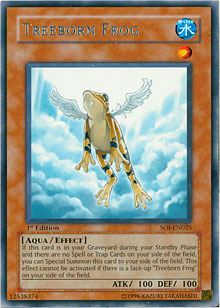 The Canadian metagame is a bit different and revolves more around Treeborn Frog and slow, controlled field presence. Nik Ristoski (DoctorNik on the forums), Walter Chen, Calvin Tsang (Canadian National Champion!), and Jordan Denk (g0bstopper on the forums) have all chosen to forgo Call of the Haunted, while many American players (such as myself, John Jensen, and Anthony Alvarado) still love the trap card.
The Canadian metagame is a bit different and revolves more around Treeborn Frog and slow, controlled field presence. Nik Ristoski (DoctorNik on the forums), Walter Chen, Calvin Tsang (Canadian National Champion!), and Jordan Denk (g0bstopper on the forums) have all chosen to forgo Call of the Haunted, while many American players (such as myself, John Jensen, and Anthony Alvarado) still love the trap card.
In this deck, Call of the Haunted is too valuable to ignore. It lets us follow up with battle damage through Airknight Parshath, helps us set up tributes, counters Creature Swap, and helps us use our own Creature Swap in case of defenses. Since Strike Ninja is removing mostly harmless targets, other than Sangan (we want to use Call on Airknight, Exiled Force, or Sangan), the card should be fine.
Ring of Destruction goes in as well. It’s probably one of the best traps in the game. We can close out the list with a copy of Bottomless Trap Hole to stop Hydrogeddon, Asura Priest, Breaker the Magical Warrior, and pesky Monarchs. Close the list with a powerful end-game condition, Return from the Different Dimension, and the deck is looking wonderful. After using all the life point payment cards in the early game (don’t hesitate to use My Body as a Shield on the very first destruction effect you see), the end-game price should be rather negligible. With three Warriors that can remove themselves from game searchable with two Reinforcement of the Army cards and an easily searchable Strike Ninja (not to mention the popular cards Bottomless Trap Hole, D. D. Warrior Lady, and Nobleman of Crossout you will face), it doesn’t look like such a bad call.
Traps: 6
Mirror Force
Torrential Tribute
+ 1 Ring of Destruction
+ 1 Call of the Haunted
+ 1 Bottomless Trap Hole
+ 1 Return from the Different Dimension
Expected Matchups with the Best Decks in the Format
Unfortunately for him, the speed that Dale used for his deck, in an attempt to beat the random Cyber-Stein splash, was not enough. He ended up bowing out of the tournament to the mighty power of that monster and its fusion friends. Our deck still packs much of the speed of his build while sticking to a lot of the control methods that Hugo tried to utilize. Asura Priest, D. D. Assailant, and Strike Ninja add some brute power to a deck that was sorely in need of it without sacrificing any cards. Spy can swarm for a lot of damage as well—while also setting up tributes—and our spell additions allow for more recoverable overextensions.
This build is not superior to its forefathers. It’s just different and tailored to my play style and preferences. The early game is robust, with almost every monster in the deck making a good opening set. The mid-game starts to open up as we convert cards in hand to combat tricks and benefit from forced simplification. In the late game, the dual win conditions of Strike Ninja and Return from the Different Dimension should push victory.
Hugo and Dale took two of the best decks with their available card pool and ended up falling just short of Top 8 contention. Nevertheless, the deck-building choices they made—unknowingly agreeing with each other—and the ideas brought forth by both Shrink builds have provided the framework for an excellent deck. While this deck may never be created in our lifetime, at least David Jamieson can get right to work play-testing for this new environment with Shrink!
New Grounds Verdict: A beautiful North American tapestry of deck building that unites Canada and the U.S.A under a happy patchwork quilt of fellowship and splendor.